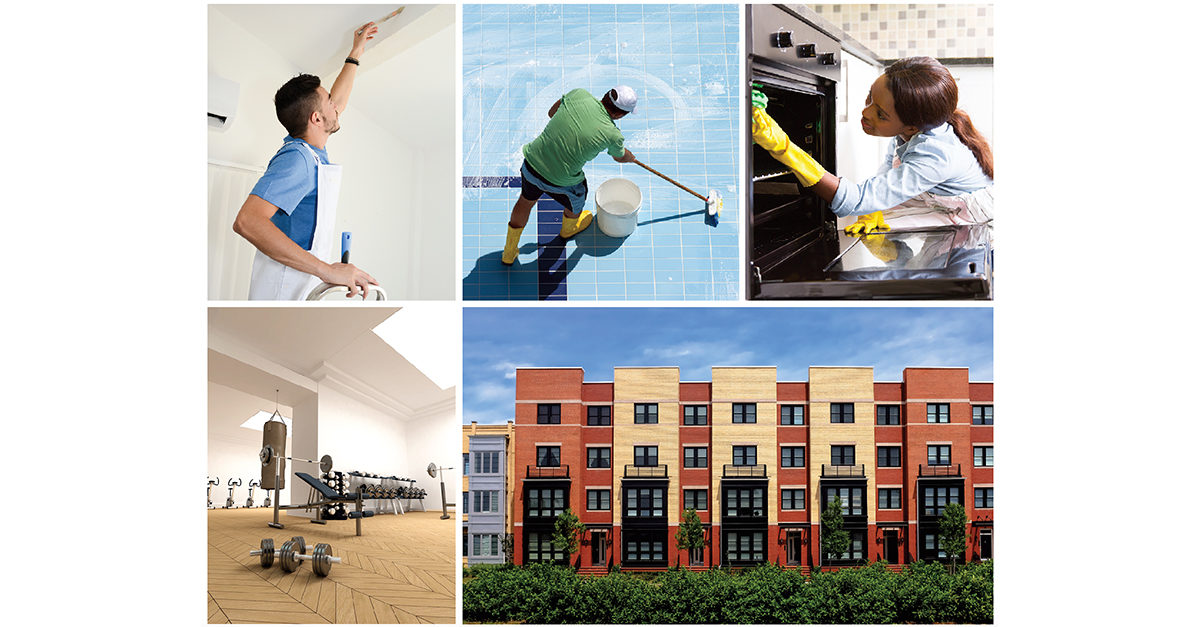Multi-family residential housing is a growing market, especially in cities that are going through a revitalization process or attempting to reinvent themselves as livable high-tech hubs. As the price of homes continues to rise, the multifamily residential market may prove to be a stable and profitable segment for diversification and growth.
This market has many sub-segments of service and specialization, which differentiate it from other segments in the commercial market. For example, these specialty services may include turnover cleaning of vacant units (cleaning, painting, and repairing); regularly cleaning common areas, kitchens, clubhouses, recreation areas, and pools; day porter services; post-construction and remodel cleanup; and pet stain and odor removal, to name several.
Management Approaches to Cleaning
Some multifamily residential locations employ in-house staff to clean and maintain their facilities, while others hire contractors to perform regular cleaning work. Others incorporate a combined approach in which they hire in-house employees for some tasks and work with independent contractors for less frequent and/or more specialized tasks.
Marketing Your Services
When conducting business in this market, you must understand the new dynamic of search engine pre-screening, ratings, and customer review websites, and how they impact the customer’s procurement process. This is especially true for next-generation buyers, including the Millennial generation and younger, as they tend to spend more time evaluating prospective service providers online and via social media.
Further, you will need to prospect and connect with the individual(s) responsible for the purchasing decision. When prospecting, consider reaching out to the facility’s maintenance director or the property owner, manager, or management firm. Real estate brokers and agents, local apartment and condominium associations, and other management services also can help you get your foot in the door with prospective buyers. Plus, a referral from your existing customers can go a long way to winning a bid in this market.
How to Price
There are multiple ways to estimate, bid, and price multifamily residential cleaning services. The most common practices include:
- Flat rate. Contractors charge a set fee or flat rate based on the size—number of bedrooms and bathrooms and/or square footage—plus any extra services the customer requests or needs. Prices range from us$125 for a studio or one-bedroom unit, to $300 or more for a unit of three, four, or more bedrooms. Costs depend on the services you provide; painting, carpet cleaning, and maintenance repairs normally incur an additional cost.
- Cost-plus or time and materials. In this scenario, the customer agrees to pay the cost of labor, supplies, chemicals, and equipment, plus overhead (9 to 15 percent) and profit (4 to 15 percent or more) or a management fee, which includes a percentage of labor—4 to 8 percent—and/or other costs, with or without a cap.
- Cost per square foot. Contractors employ this pricing model for specific types of services based on square footage cleaned. A typical equation for bidding by cost per square foot is length multiplied by width equals square feet; square feet multiplied by cost per square foot equals the cost of service for the area to be cleaned.
- Hourly rate. In this scenario, contractors establish an hourly rate for specific types of services and simply multiply the hourly rate by the number of hours it takes to complete the work. Common rates in the industry are $17 to $26 per hour, per person, with a minimum charge of one hour at $45 to $65 per person.
Reality
The reality is that residential housing is a price-driven market; 99 percent of the time, it’s all about the cost. If your price is low (or at least reasonable), you are reliable, and your quality and customer service are good, you will have plenty of work.
Disclaimer
There is no magic number or average price that will ensure you win every bid you submit. Pricing is always a major concern and something you improve upon with more practice. The best and most accurate bidding and estimating numbers come from your past experience with accounts of similar sizes and characteristics. By maintaining accurate accounting records, you gain the ability to analyze existing account information in terms of cost and profitability, and you can use this information to bid current and future jobs. No book, software, or computer program will provide you with more accurate bidding information than your own accounting numbers. When pricing bids, you must consider factors such as wage rate, competition, overhead, profit and skill, required chemicals and equipment—and how badly you want the job.




